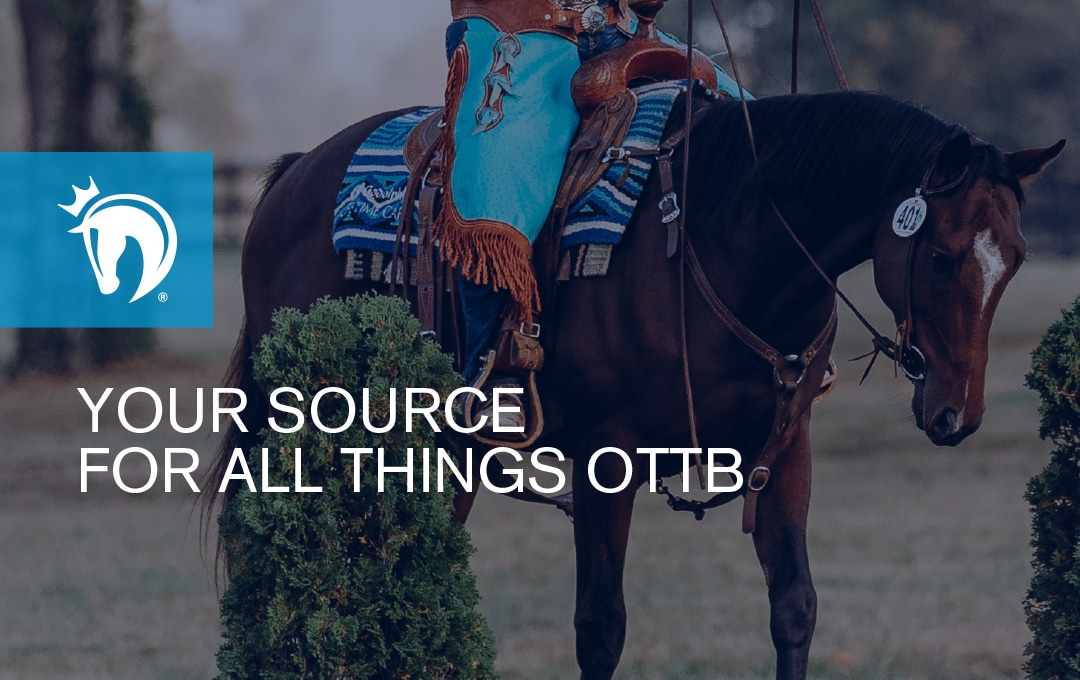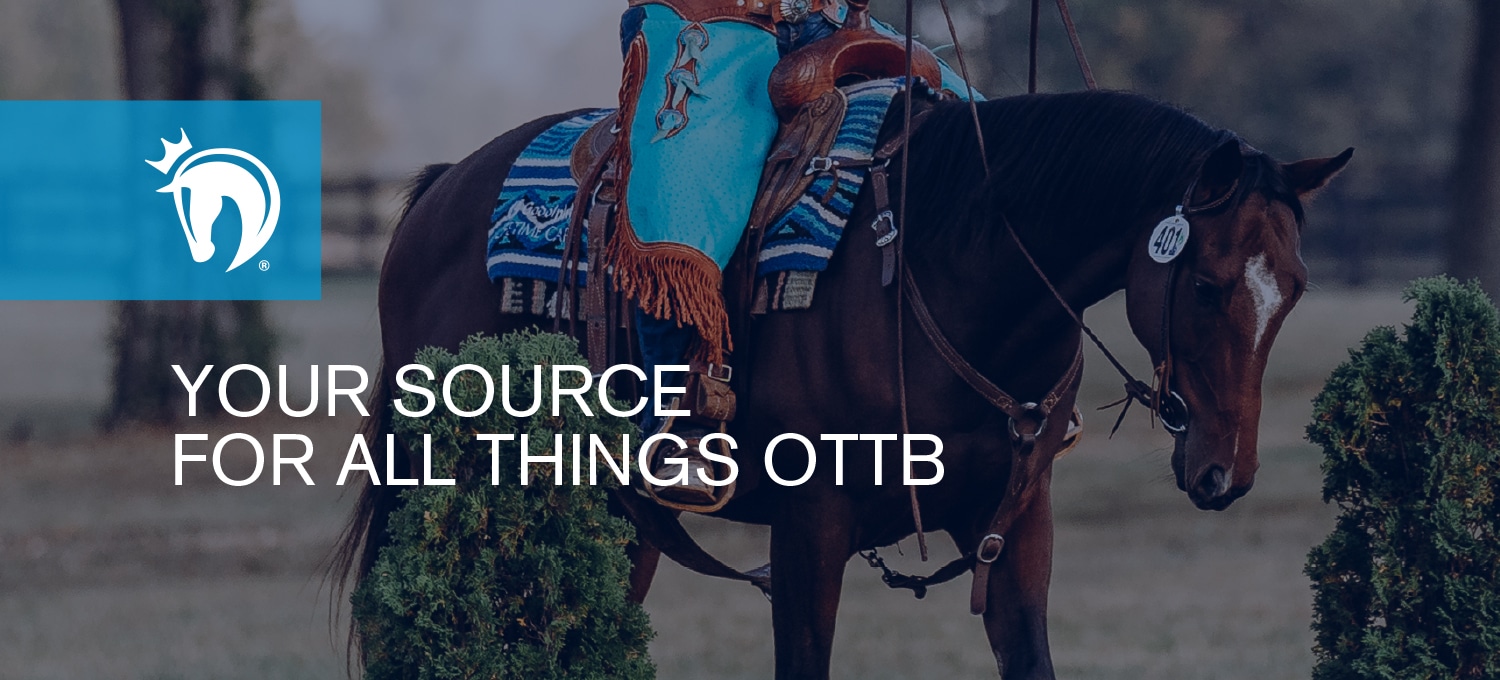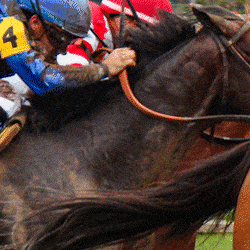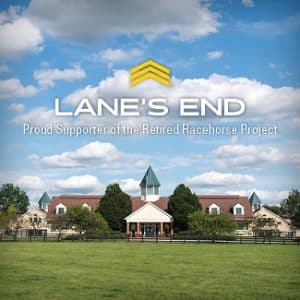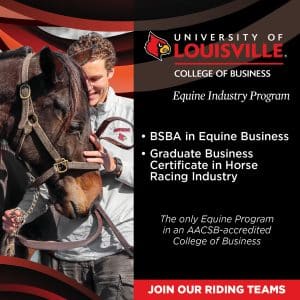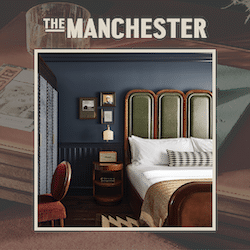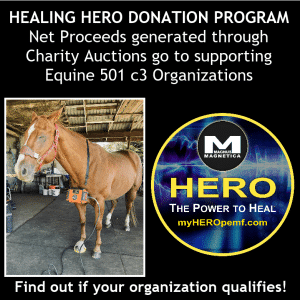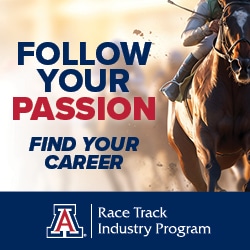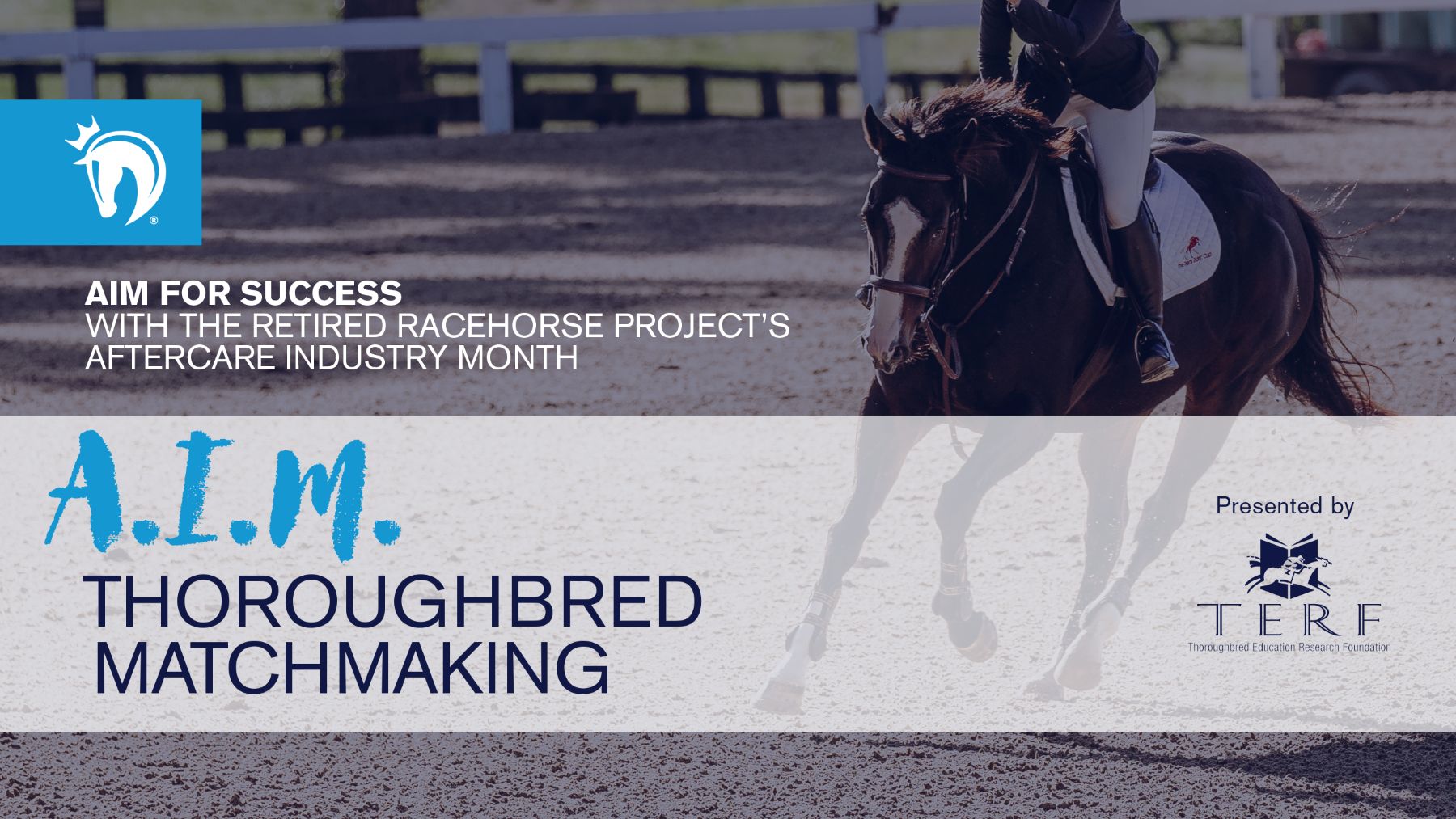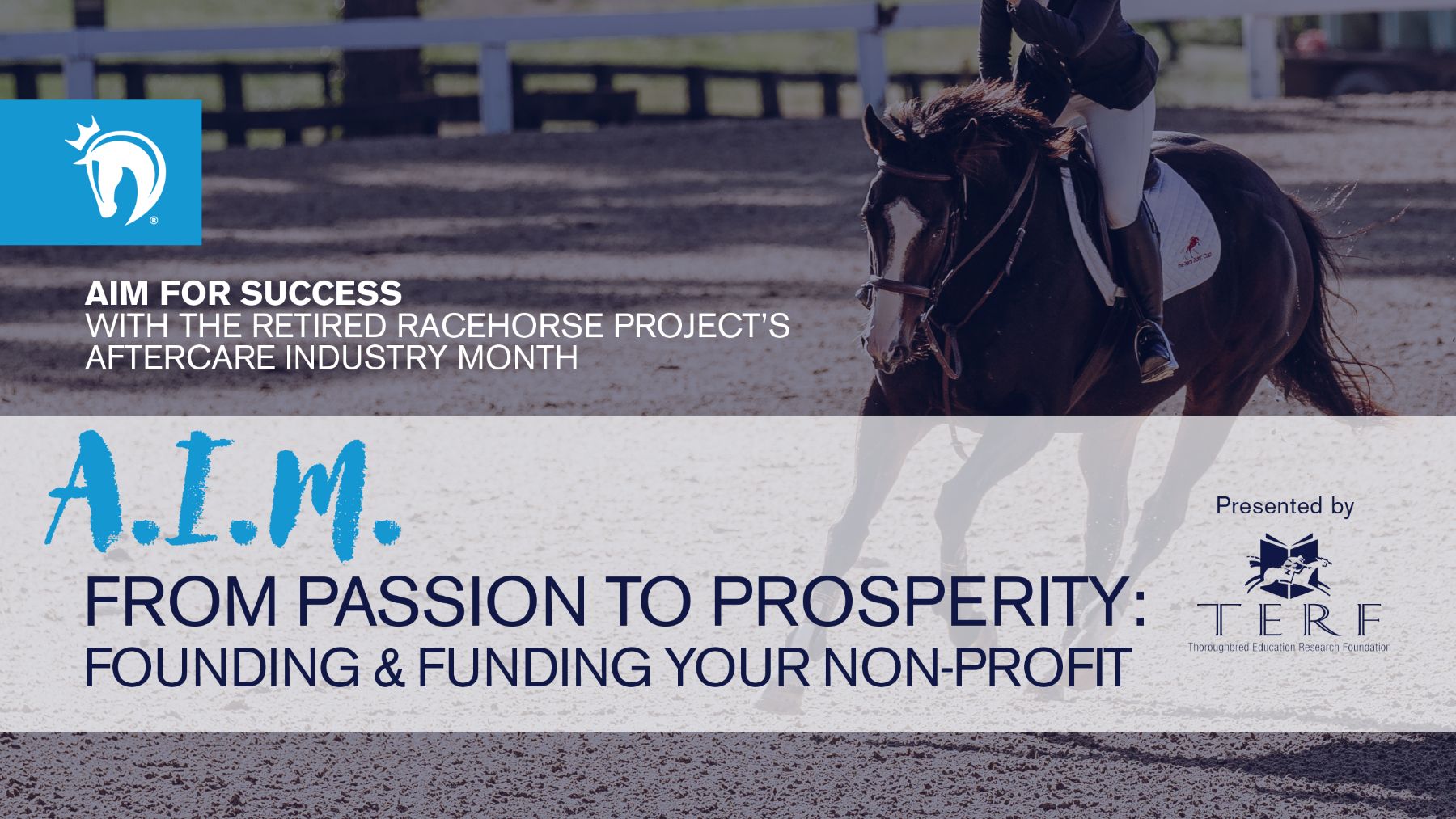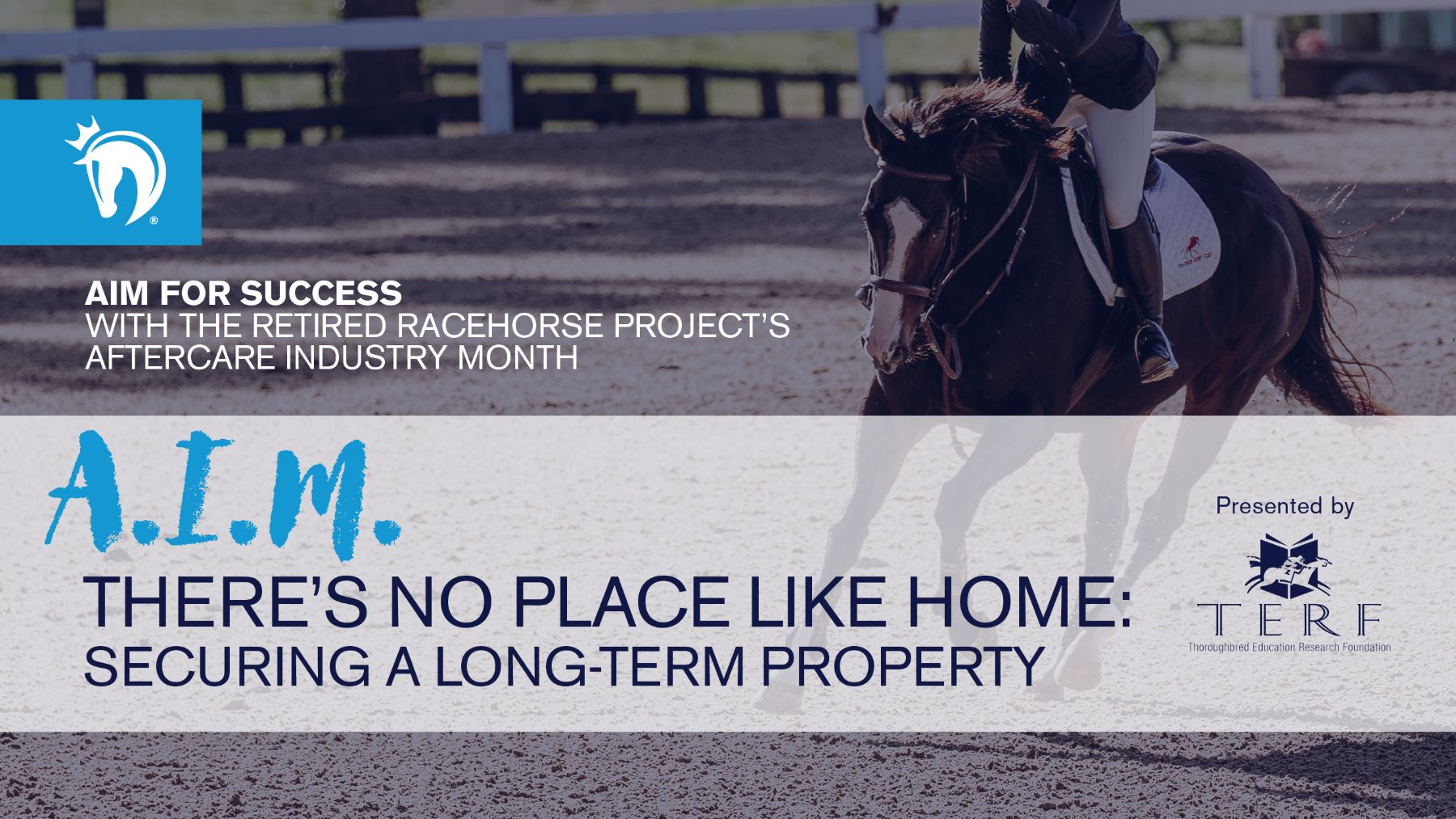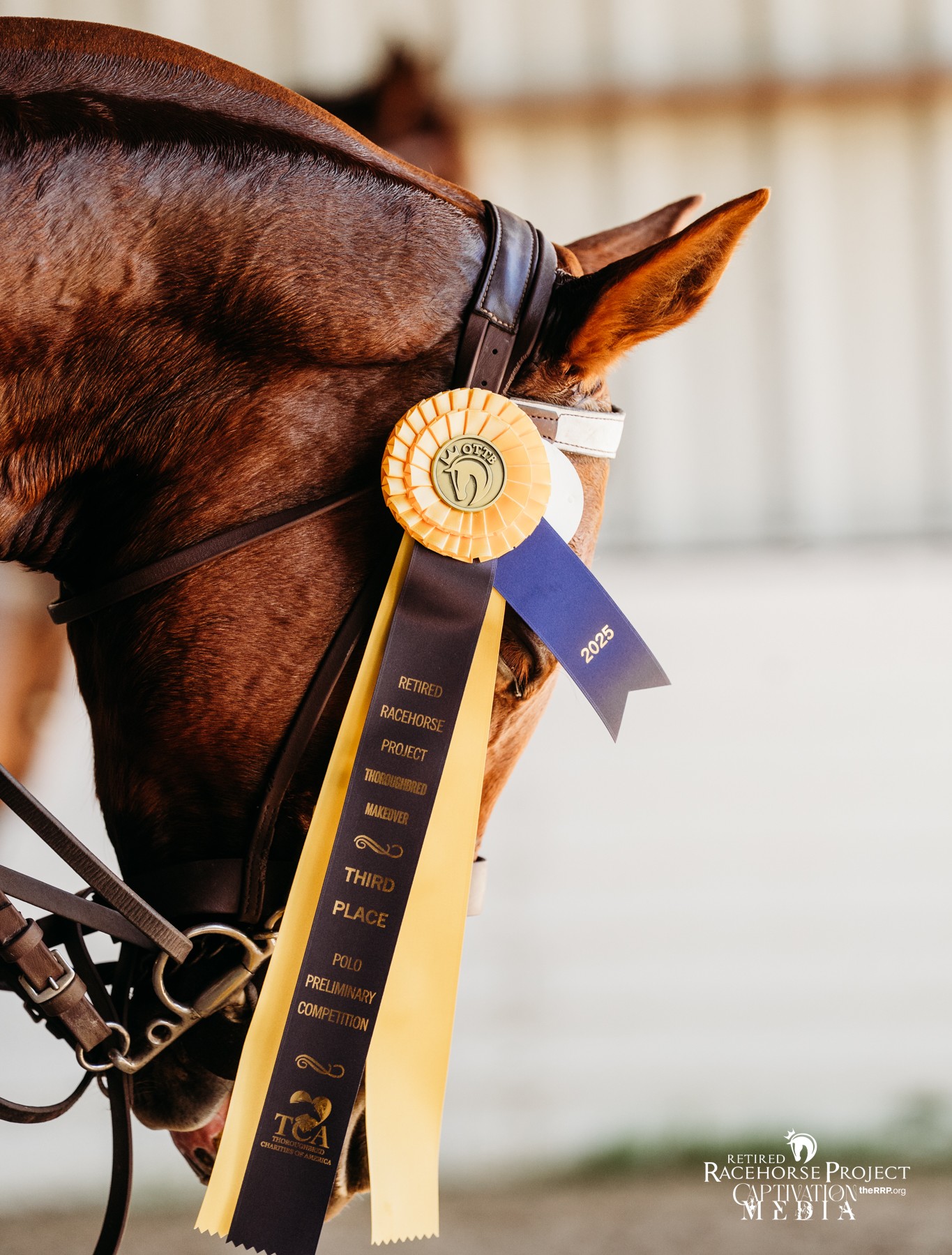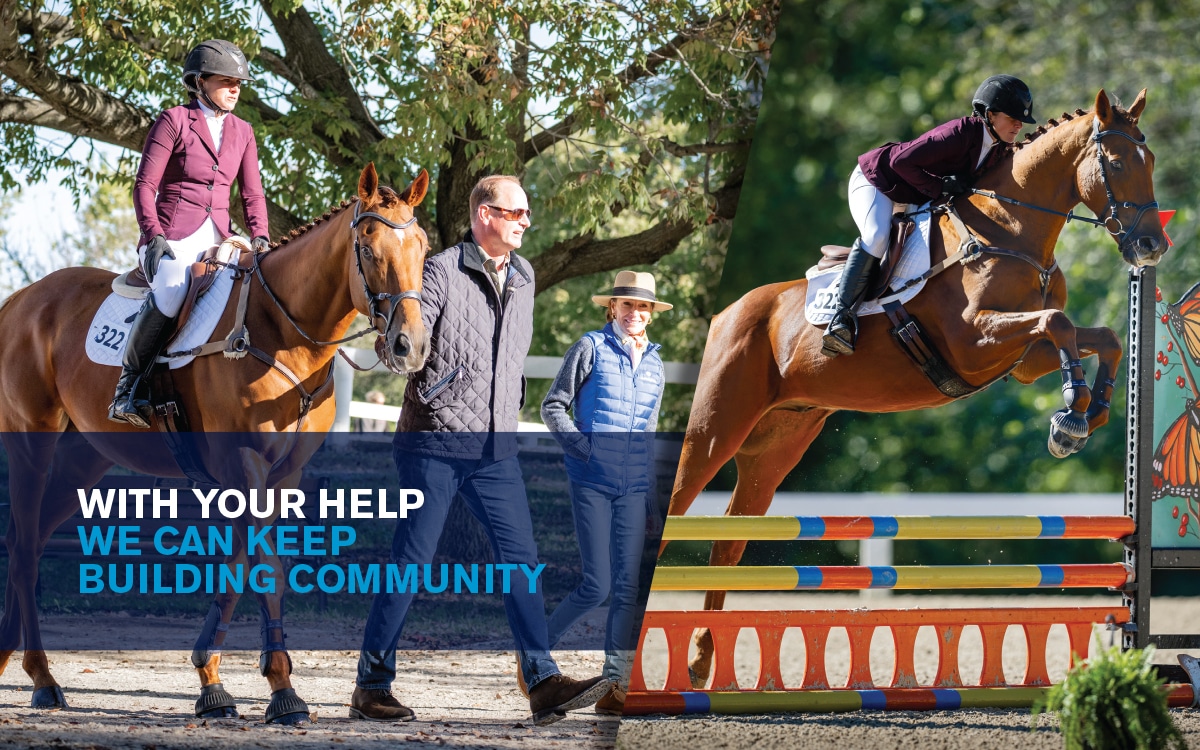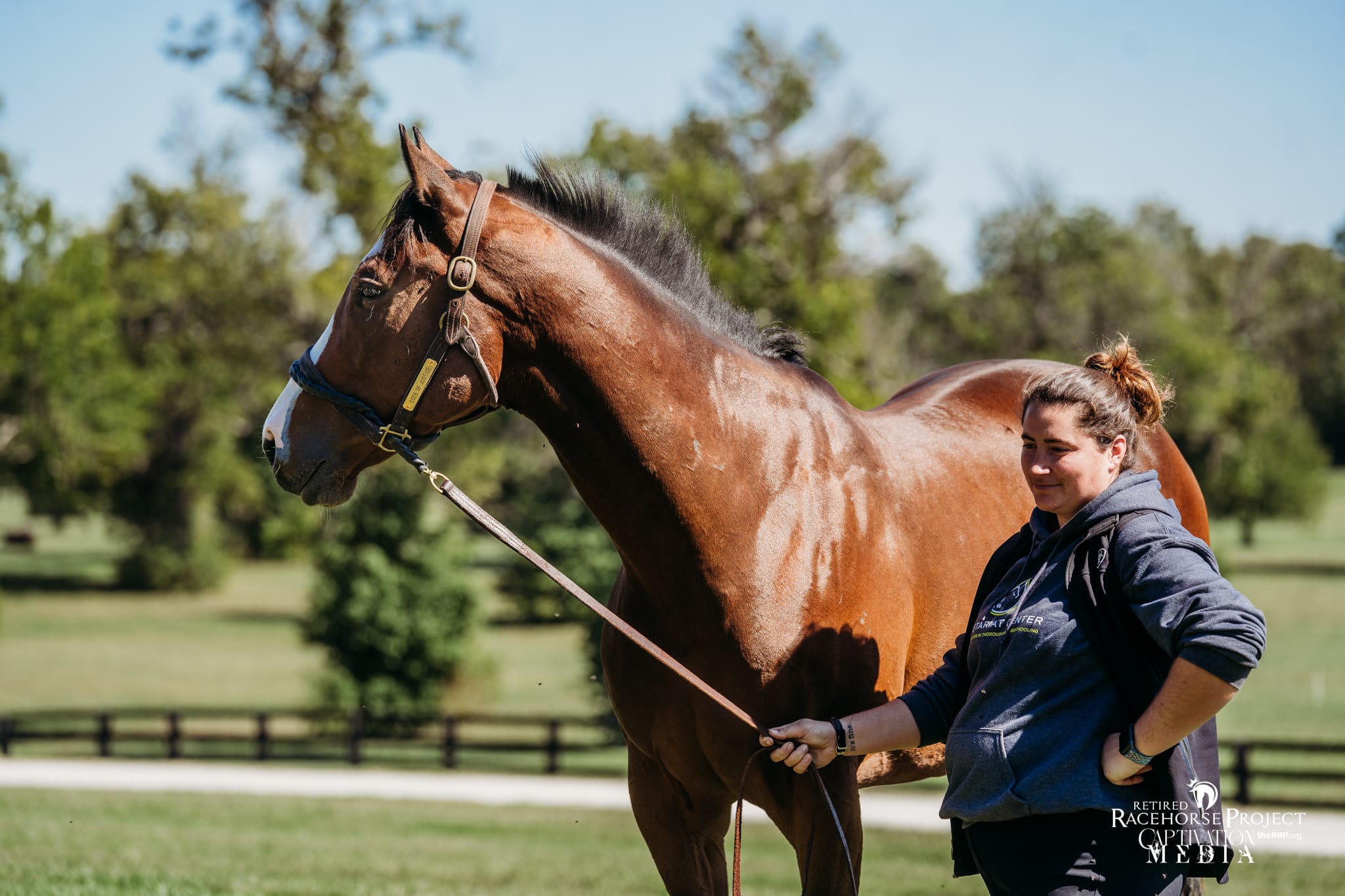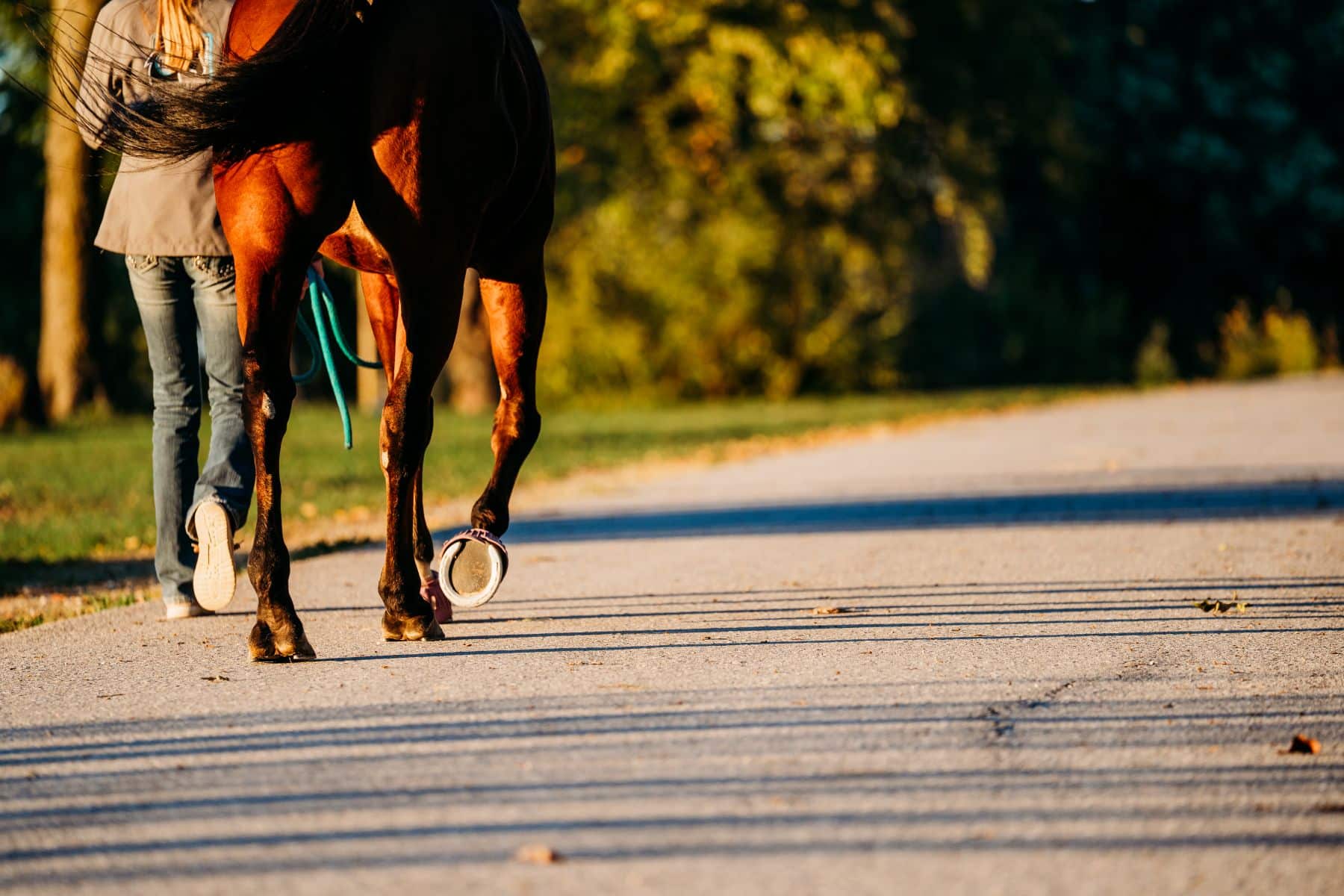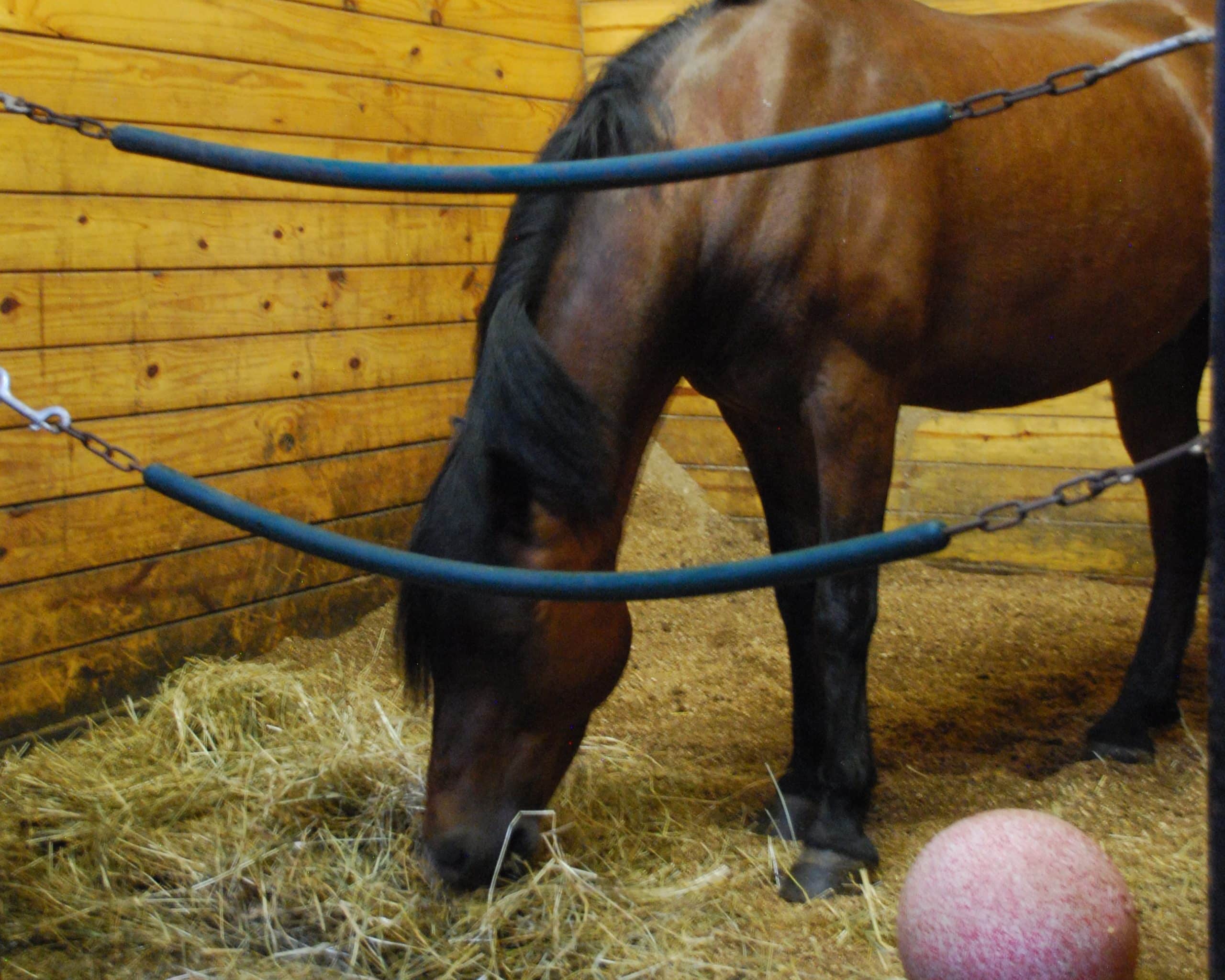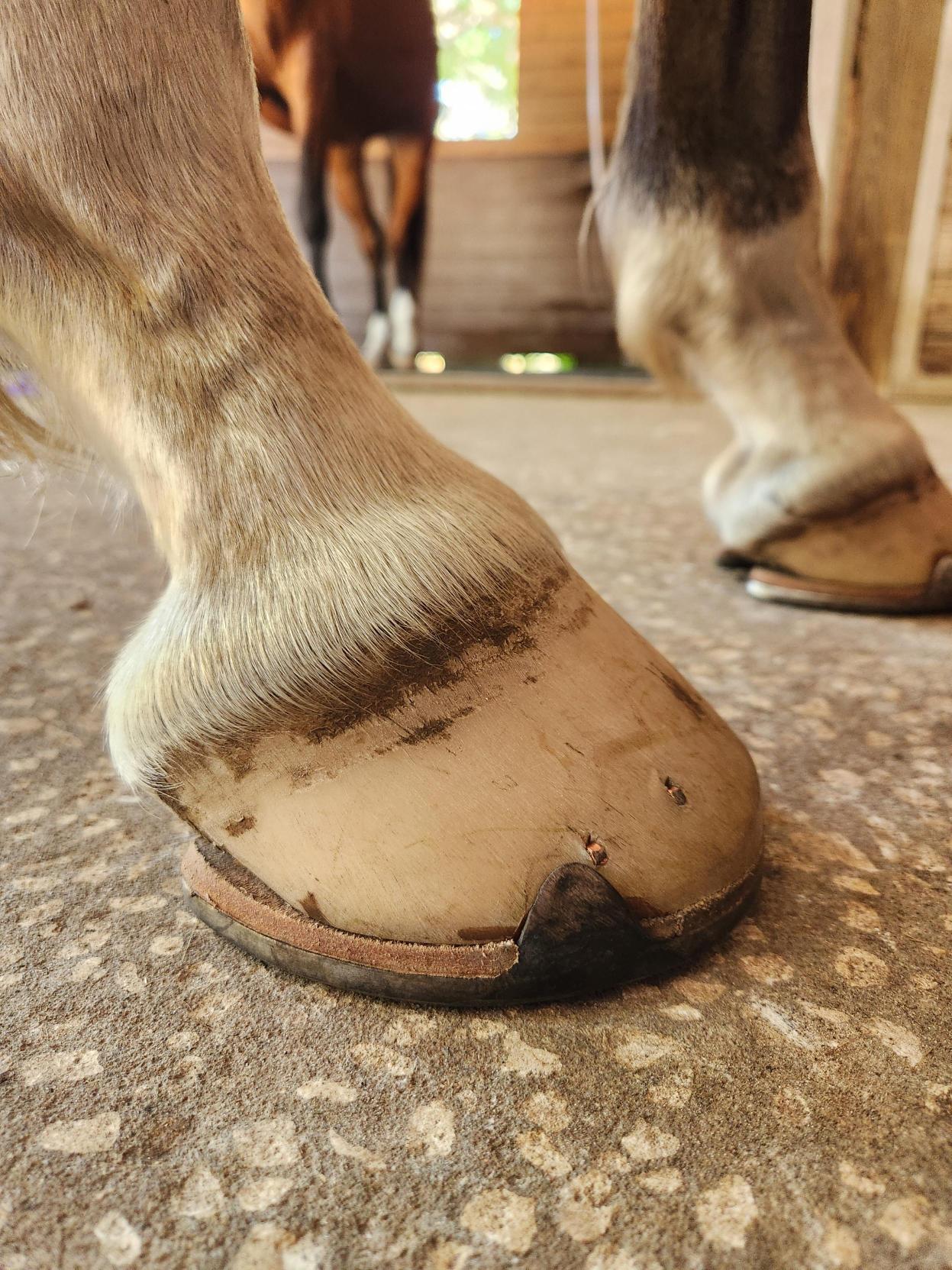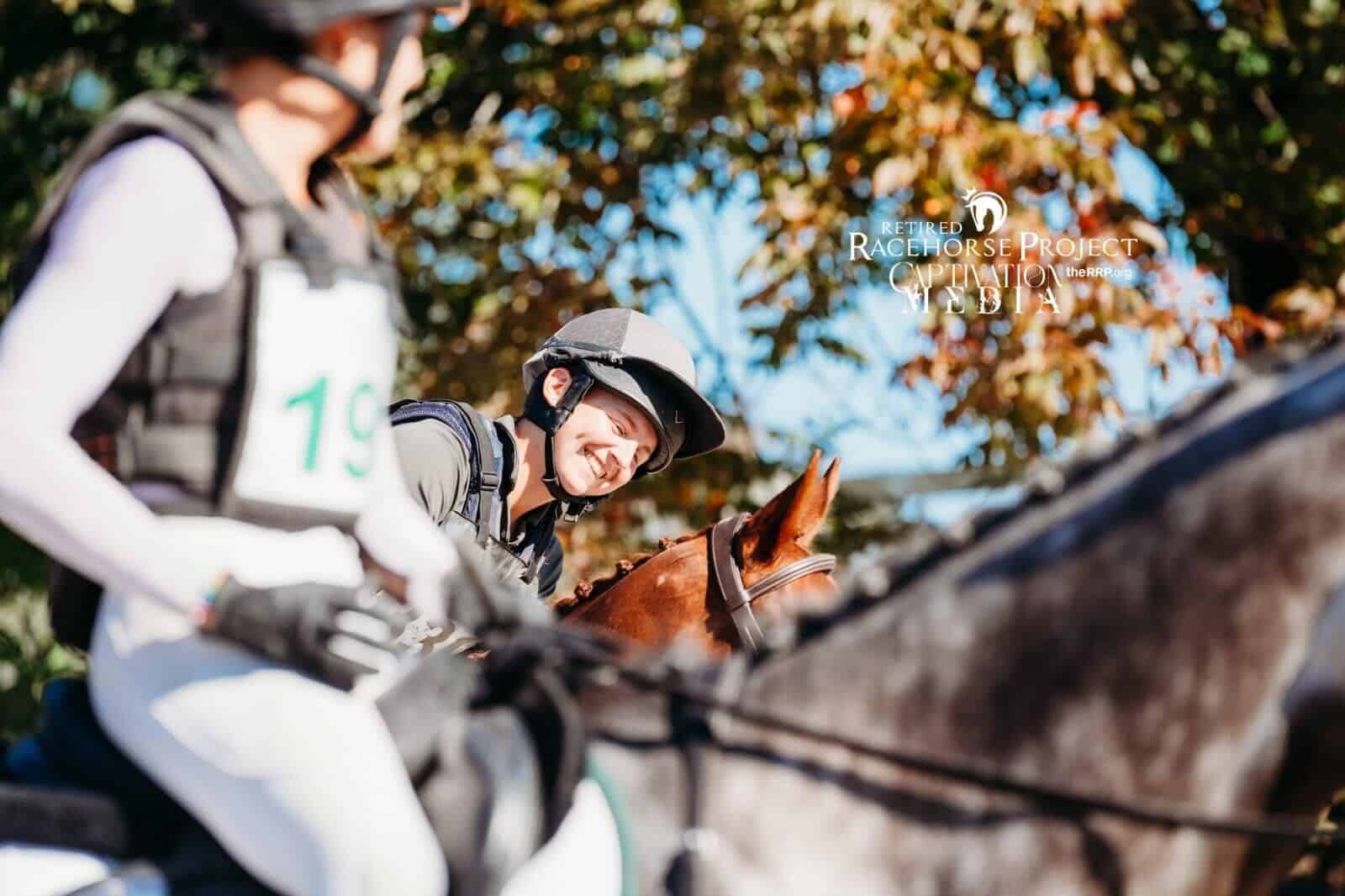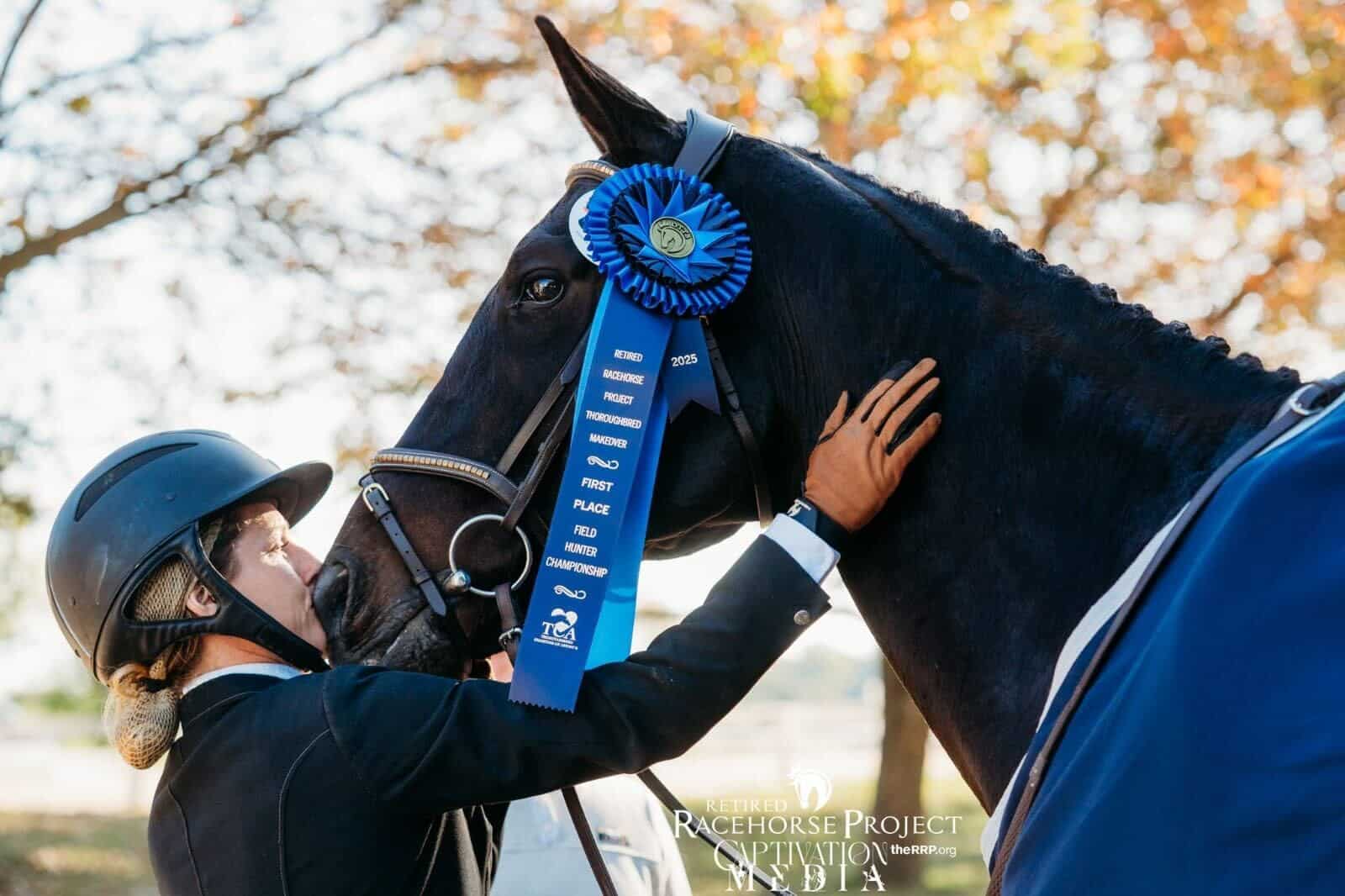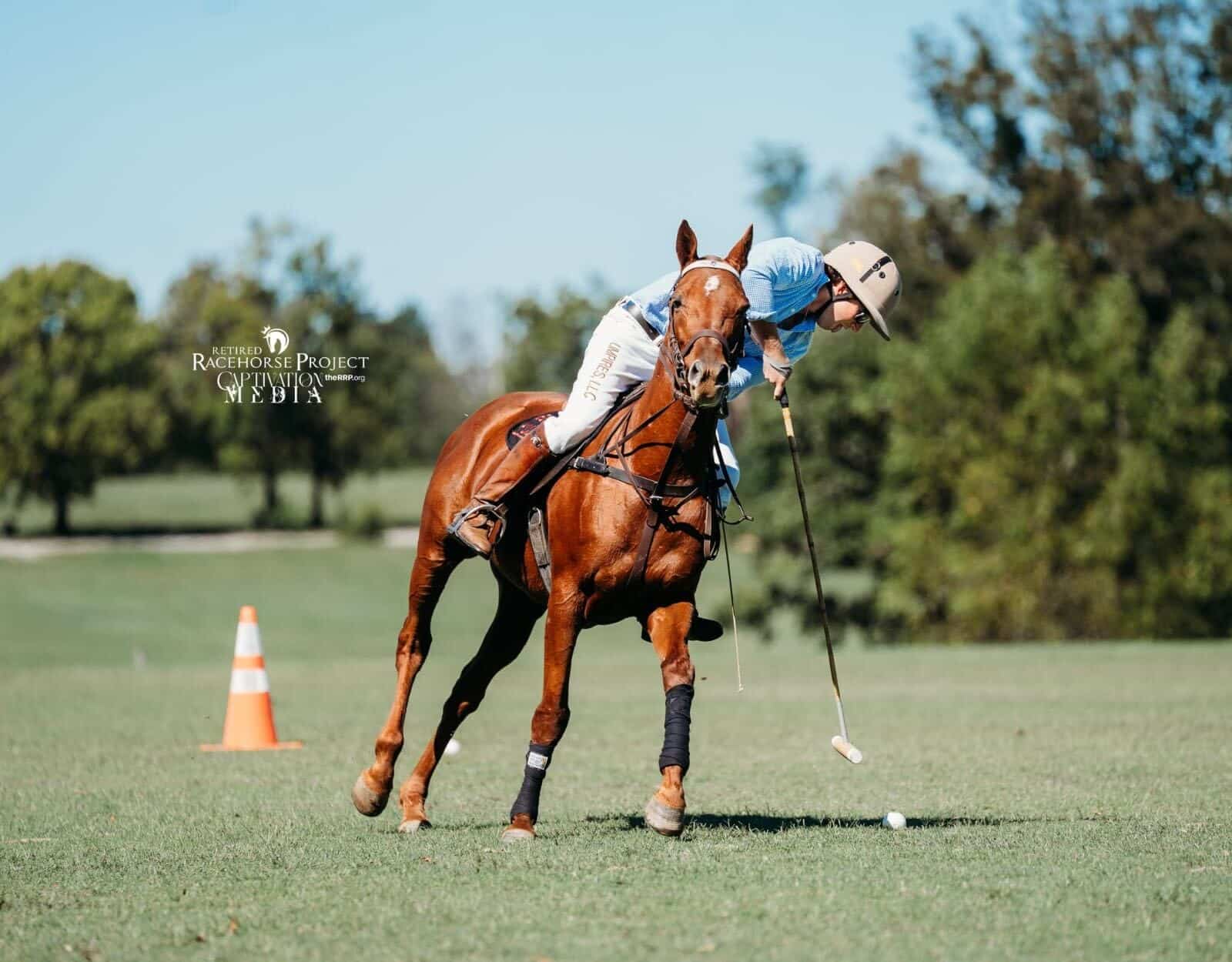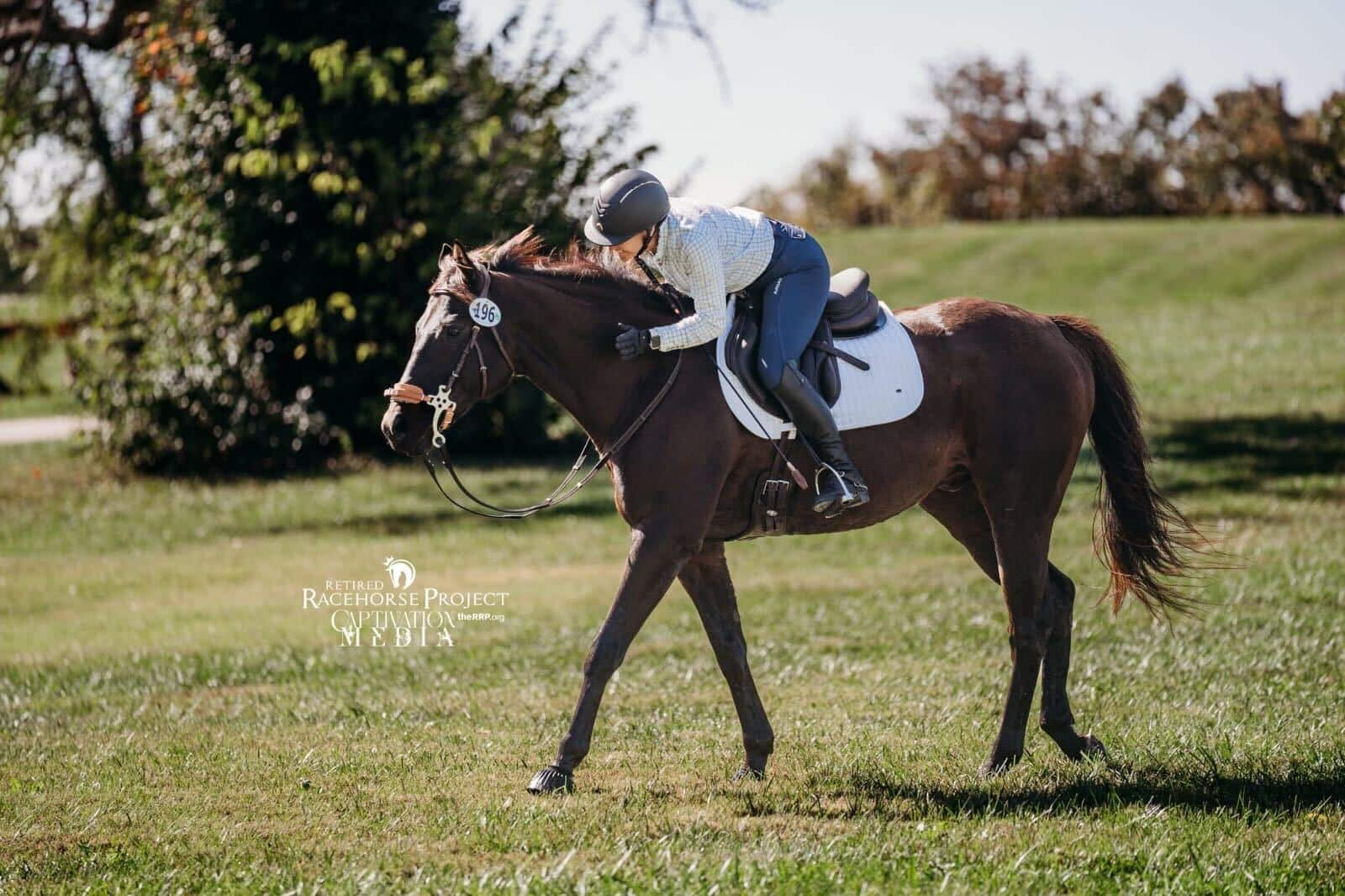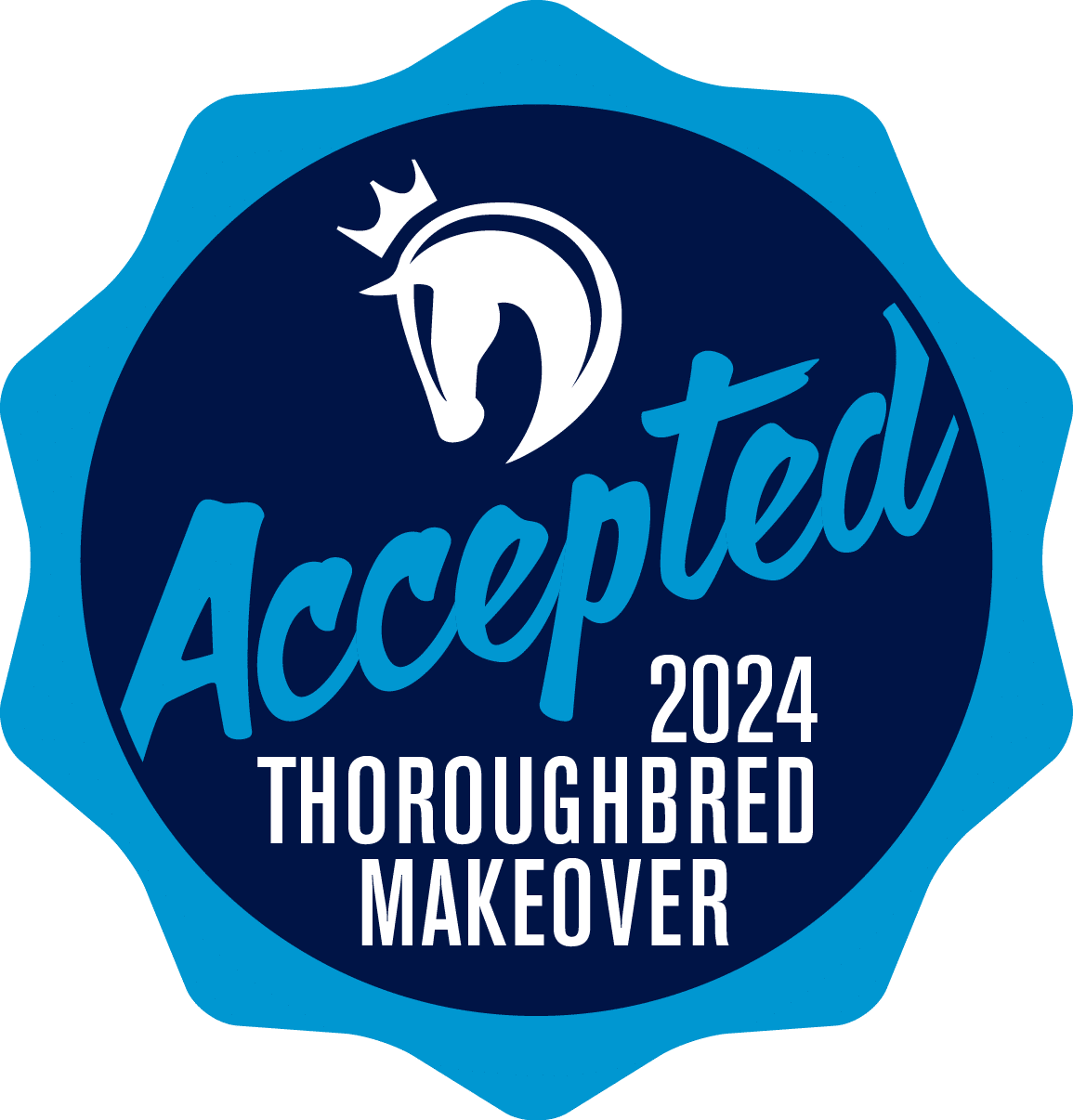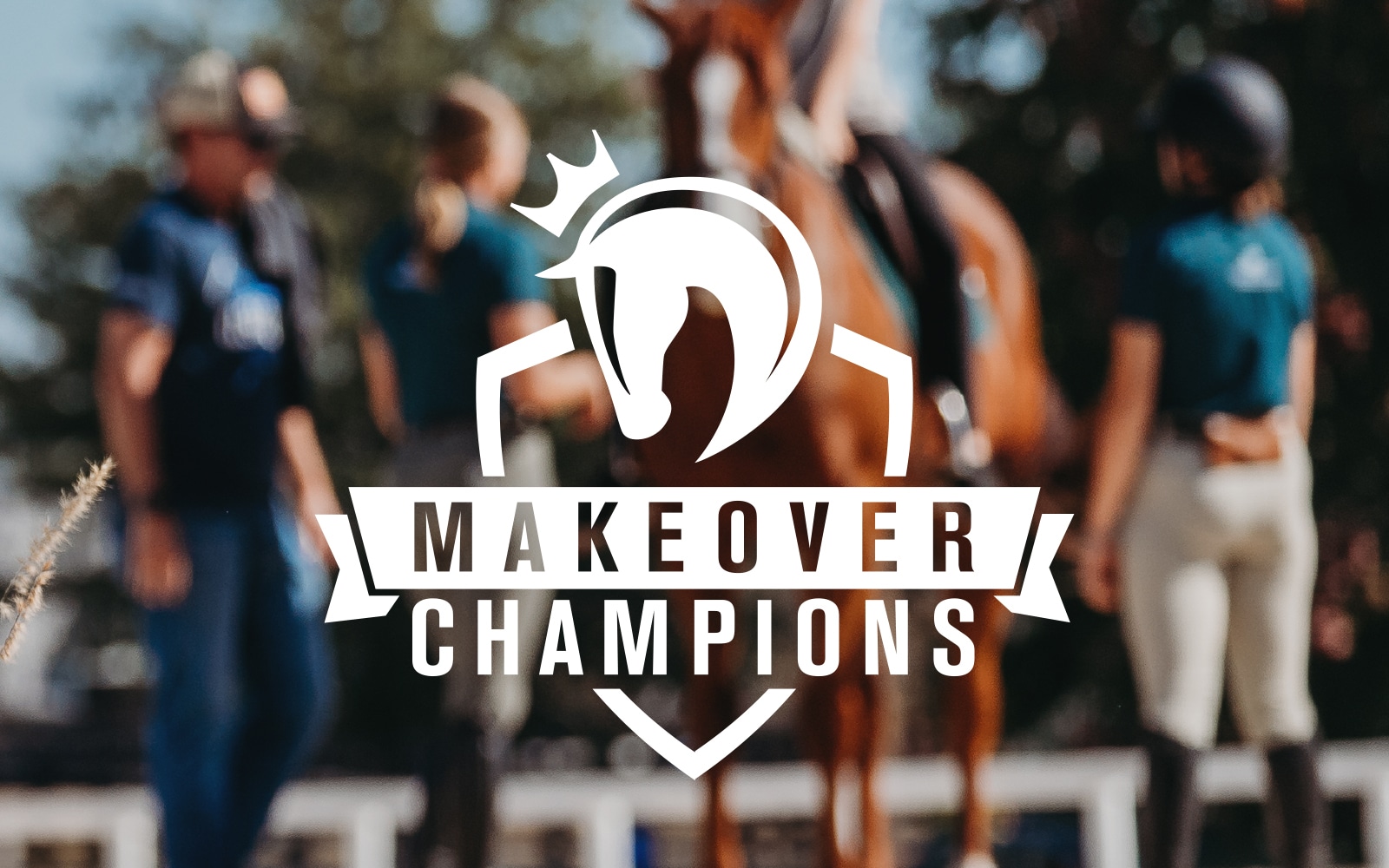Center Stage
October 09, 2020The versatile, athletic, capable off-track Thoroughbred is the star of all our stories, but every star needs a stage. The Retired Racehorse Project (RRP) built that stage and switched on the spotlight. With a social media fan base nearly 166,000 strong and an annual marquee event — the Thoroughbred Makeover and National Symposium — that attracts more than 800 applicants, it might be difficult to imagine the RRP was a mere idea 10 years ago. But a visionary founder and a small group of dedicated, determined individuals took the idea and nurtured it into the movement it is today.
The RRP’s Roots
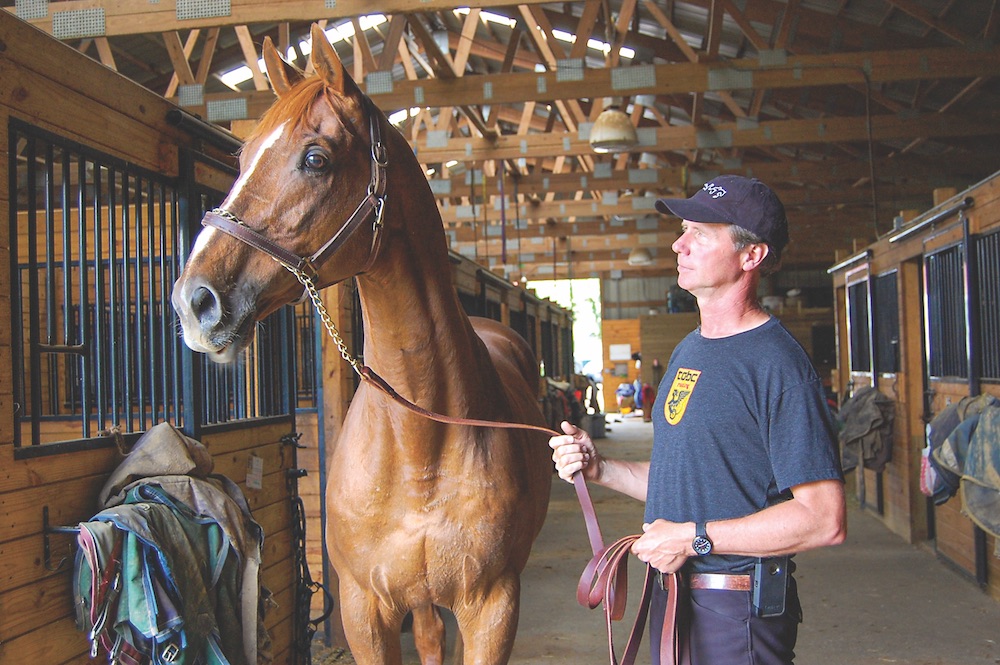
Advertising Salute the Truth as a sport horse stud at horse expos ended up being the catalyst for RRP founder Steuart Pittman’s pivot to promoting OTTBs at large. Photo courtesy RRP staff
Steuart Pittman, founder of the RRP, possessed an early fascination with Thoroughbreds, regularly visiting a neighboring Thoroughbred breeding and training farm as a child to watch the horses. “They were the most beautiful things in the world,” he says.
After graduating from 12-hand ponies to off-track Thoroughbreds, Pittman campaigned retired racers in Pony Club events and fox hunted them first field. He carried that penchant for the breed into his career training and selling event horses, buying chestnut stallion Salute The Truth (JC: Boy Done Good [Salutely — Good Queen Liz, Sir Raleigh]) off the track and turning him into a successful eventer and event horse sire.
Advertising “Willie” as a sport horse stud at horse expos ended up being the catalyst for Pittman’s pivot to promoting OTTBs at large.
“I did this little thing where I’d show him in hand,” says Pittman, “and then just swing up on his back bareback and ride around.”
Expo audiences raved at Willie’s calm agility, and organizers asked if Pittman would teach eventing-focused sessions, “jumping in a 60-by-120 little pen,” he recalls. It was here, teaching the fundamentals of cross-country over a Christmas tree and a few skinnies, he realized he could reach a lot of people with an important message quickly, and he knew exactly what that message would be.
“The Warmbloods were growing in popularity and the Thoroughbreds weren’t, because nobody was marketing them for sport,” says Pittman. “And it was clear that it was because (OTTB trainers and enthusiasts) didn’t have an association around which to mobilize; The Jockey Club’s job was not to market horses for sport.
“I thought, ‘Somebody needs to be promoting Thoroughbreds,’ ” he says. “Somebody needs to be showing people that you can take a horse off the track and turn it into just about anything you want.”
Pittman continued showing Willie at expos for a couple of years, then organized and moderated the Retired Racehorse Training Symposium, a 2009 event held at a nonprofit organization in Maryland. “I brought in people I knew with Thoroughbreds off the track at different stages of training,” he explains. “So we started with a horse who had done no training off the track, and we ended with a horse that was in its 20s, who had taught both a mother and daughter how to event through the one-star level and everything between.”
The paid event attracted more than 300 people. “They sat there for four hours,” he says. “They loved it.”
An Idea Whose Time Had Arrived
About this time Malinda Lawrence, an eventer and OTTB owner, had attended several clinics Pittman taught and kept hearing about his idea for establishing an organization to promote retired Thoroughbred racehorses. Pittman needed a newly minted OTTB to exhibit at expos but already had a full barn of horses, and Lawrence was looking for her next prospect. Enter Eli, a big gray they got off the track in 2010.
While Pittman and Eli captivated crowds at expos, Lawrence, an attorney, committed to the organizational concept as founding board member and applied for IRS recognition of the RRP’s 501(c)(3) status.
From there, the organization’s activities picked up momentum with the RRP’s website launch in 2011 and the announcement of a 100-Day Trainer Challenge to be held the following year. Pittman also traveled to Lexington, Kentucky, in 2011 to share his vision of marketing Thoroughbred ex-racehorses as sport horses to an expanded group of industry stakeholders; up until this point most of the RRP’s funding had come from the Maryland Thoroughbred industry. Members of the racing and Thoroughbred aftercare industry convened at Keeneland Race Course and the Maker’s Mark Secretariat Center (which prepares OTTBs for post-track careers) and pondered Pittman’s message.
“I was promoting a more market-based approach there,” he recalls, “saying, ‘Look, there are great people who are individuals who have the ability to transition a Thoroughbred. And there are thousands of farms across the country that have the facilities where this can be done.’ ”
He also announced his intent to one day offer a training competition for these individuals offering $100,000 of prize money.
The idea especially resonated with Dan Rosenberg, former president of Thoroughbred Charities of America (TCA), and Erin Crady, executive director of this organization that provides funding to entities working to uphold its mission of providing a better life for Thoroughbreds during and after racing.
“At that time Steuart’s concept was pretty unique within the Thoroughbred industry,” says Crady. “His goal was to expand the market for off-track Thoroughbreds in second careers via clinics, expos, training publications and videos. More of a focus began to be placed on the importance of Thoroughbred aftercare, and I think Steuart recognized that the aftercare organizations were only one piece of the puzzle.
“TCA believes that there is a need to fund not only the aftercare organizations (which it qualifies each year via an application process) that are rehabbing, retraining and rehoming Thoroughbreds … (but also) the organizations that are working to create a market for off-track Thoroughbreds. Organizations like RRP that incentivize equine enthusiasts to choose a Thoroughbred as their next mount assist in the movement of horses through aftercare organizations and into their second careers.”
After these meetings in Kentucky, the RRP’s activities began to cover ground at a fast clip. “It was very, very clearly an idea whose time had just arrived,” says Lawrence. “It coincided with the recession, which almost helped because all of a sudden (the sport horse industry was) interested in less-expensive quality horses.
“There was all this interest and energy swirling around the Thoroughbreds,” she adds, “and there had never been anything to catch it and channel it, and this was the perfect time and place.”
The Cornerstone: The Thoroughbred Makeover
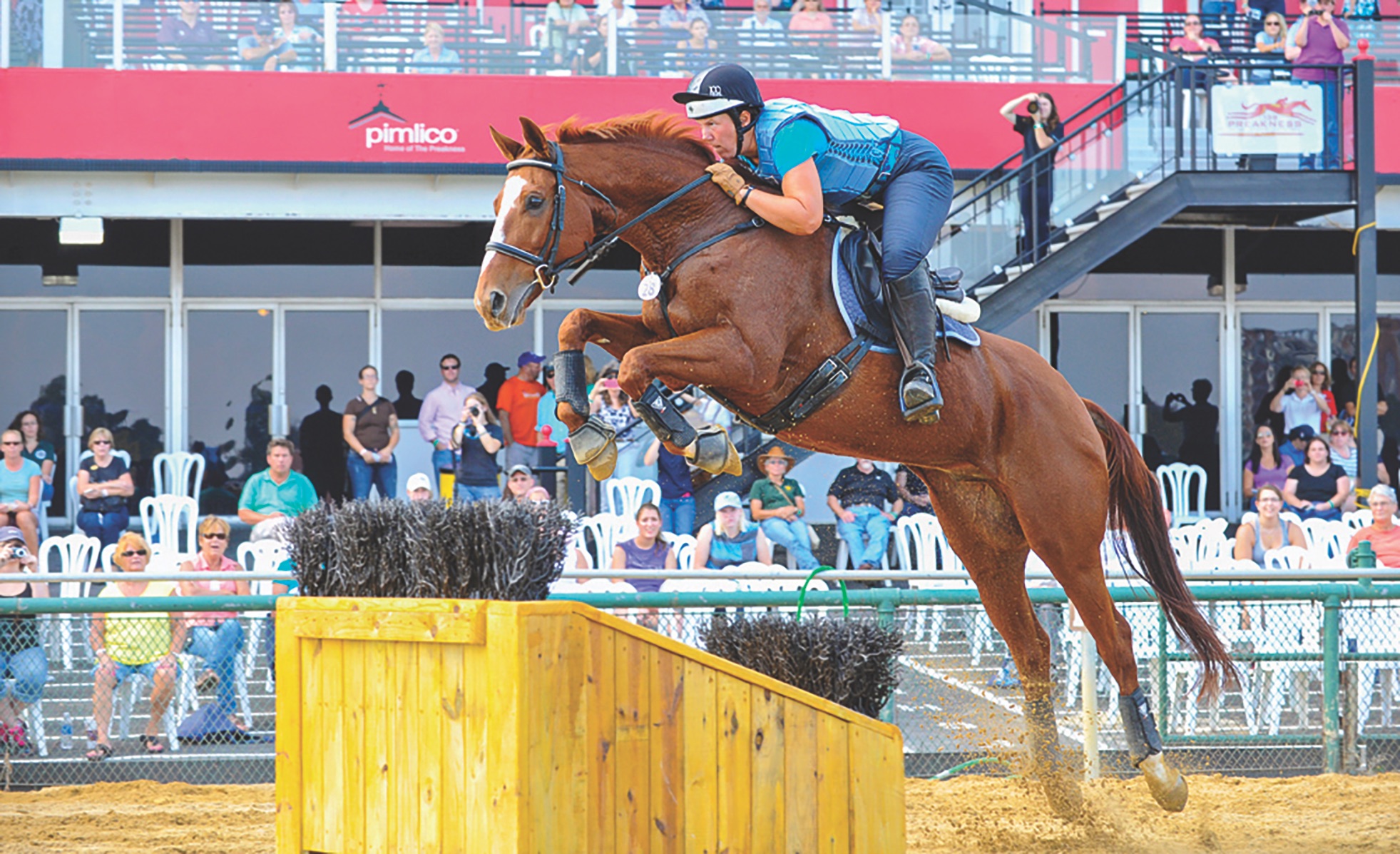
The inaugural Thoroughbred Makeover took place in 2013 at Pimlico Race Course and showcased 26 OTTBs. Photo courtesy Sarah K. Andrew
The 100-day trainer challenge of 2012, featuring four trainers each preparing a horse for its second career, segued into a bigger event in 2013.
Carolyn Karlson, a professor of entrepreneurship, RRP board chair and racehorse owner, had been taking an equine nutrition class over her lunch hour twice a week from Erin Pittman, Steuart’s wife, at the University of Maryland, to better understand how to feed the filly she was racing at the time. This led to her learning about the process of transitioning her filly to be a riding horse—which happened at the Pittman family’s Dodon Farm — and into the world of aftercare.
“I decided to fund the first Makeover at Pimlico after the Sandy Hook Elementary School shooting that occurred in December 2012,” says Karlson. “I know that sounds like a bizarre connection but, following that horrible event, I recall NBC anchor Ann Curry asking people to perform acts of kindness in honor of the children who died.
“I came up with the idea to donate $26,000 ($1,000 for each child and adult who died in the shooting) to the Retired Racehorse Project to turn around and sponsor 26 trainers to take 26 racehorses fresh off the track and retrain them for second careers,” she adds. “Somehow we convinced Pimlico Race Course to host this event for us to show off the horses’ transitions, and hundreds of people showed up to watch.”
Thoroughbred Charities of America became the title sponsor of the Makeover at that inaugural event and has been ever since.
Jen Roytz, now the RRP’s executive director, working in Thoroughbred industry marketing and media, covered the Makeover that year for the Paulick Report. As an experienced rider who had both exercised racehorses and transitioned them to hunter/jumper mounts, she was impressed with the event’s outcome.
“The Thoroughbred Makeover and National Symposium really put the RRP on the map,” says Roytz. “It began as a small showcase on the homestretch of Pimlico to display the transformation a Thoroughbred can make from racehorse to riding or show horse in that first year after racing. Over the past decade and especially in the past five years, the event has become the cornerstone of our organization.
“Seeing what the audience turnout and reaction was to those first events at Pimlico and elsewhere showed all of us that there was a monumental desire to help Thoroughbreds recapture the respect and status they once enjoyed outside of racing as competition and recreational mounts.”
The Expansion
Pittman had recruited Kirsten Green, now the RRP’s managing director, as a volunteer to run the stabling at the 2013 Makeover, and she came on staff full time in 2014. The event that year featured just 10 horses, but Pittman and the board had plans to move the Makeover to the Kentucky Horse Park, in Lexington, in 2015.
This was a big step for the organization, says Green, who had expected around 100 applicants. Ultimately, about 350 applied and 185 competed that fall. The organization also launched Off-Track Thoroughbred Magazine at the event to herald these horses and further promote the RRP’s mission.
“Our transition helped move the perception of the Makeover from a mid-Atlantic to a national event,” adds Karlson. “It also took us off the racetrack to ‘demo’ equestrian sports to a venue with bona fide dressage rings, cross-country courses, etc. Our trainers didn’t just give a short demo — they actually competed.”
Moving to the Horse Park also allowed the RRP to expand its division offerings, giving polo, working ranch and barrel racing trainers a platform to showcase their skill and the breed’s versatility.
In addition, the event finally offered that $100,000 in prize money, thanks to TCA’s sponsorship. Crady helped with the judging and found one moment particularly poignant.
“I remember the first time that all 10 discipline winners were brought into the covered arena to receive their ribbons and take their victory gallops,” she says. “It was a really inspiring moment to watch so many recently raced Thoroughbreds excelling in new careers. You could almost see how proud the horses were of themselves, too.”
Organizers, supporters and participants also enjoyed camaraderie unlike anything the RRP had seen. Karlson says stabling placed dressage riders next to team penners and polo players, creating an organic opportunity to learn about each other’s sports and the many ways to retrain an OTTB.
Green notes that the effect was unintended but has become a striking characteristic of the event. “The Makeover can be credited with leveraging hundreds of horses into new careers each year, thousands since its inception,” she says. “When we moved the Makeover to Kentucky, we also established a community of like-minded people who are united in their love of Thoroughbreds and unwavering in their kindness and support with one another.
“Although the community isn’t a direct service to the horses, I really believe that they’re benefiting from it,” she adds. “It’s easier to get horses into appropriate homes, get them good training or solve issues on care when you’ve got a vast community of people with diverse experience to network with and use as a sounding board.”
Roytz, who by this point had joined the RRP board, says after the Makeover moved to Kentucky and could accommodate more entries, it expanded exponentially. “Our application numbers were growing from one year to the next at a rate we could have never anticipated, and the event proved to be not just a competition but the nation’s largest coming-together of those from around the country with a vested interest in Thoroughbreds in nonracing sports.”
The Evolution
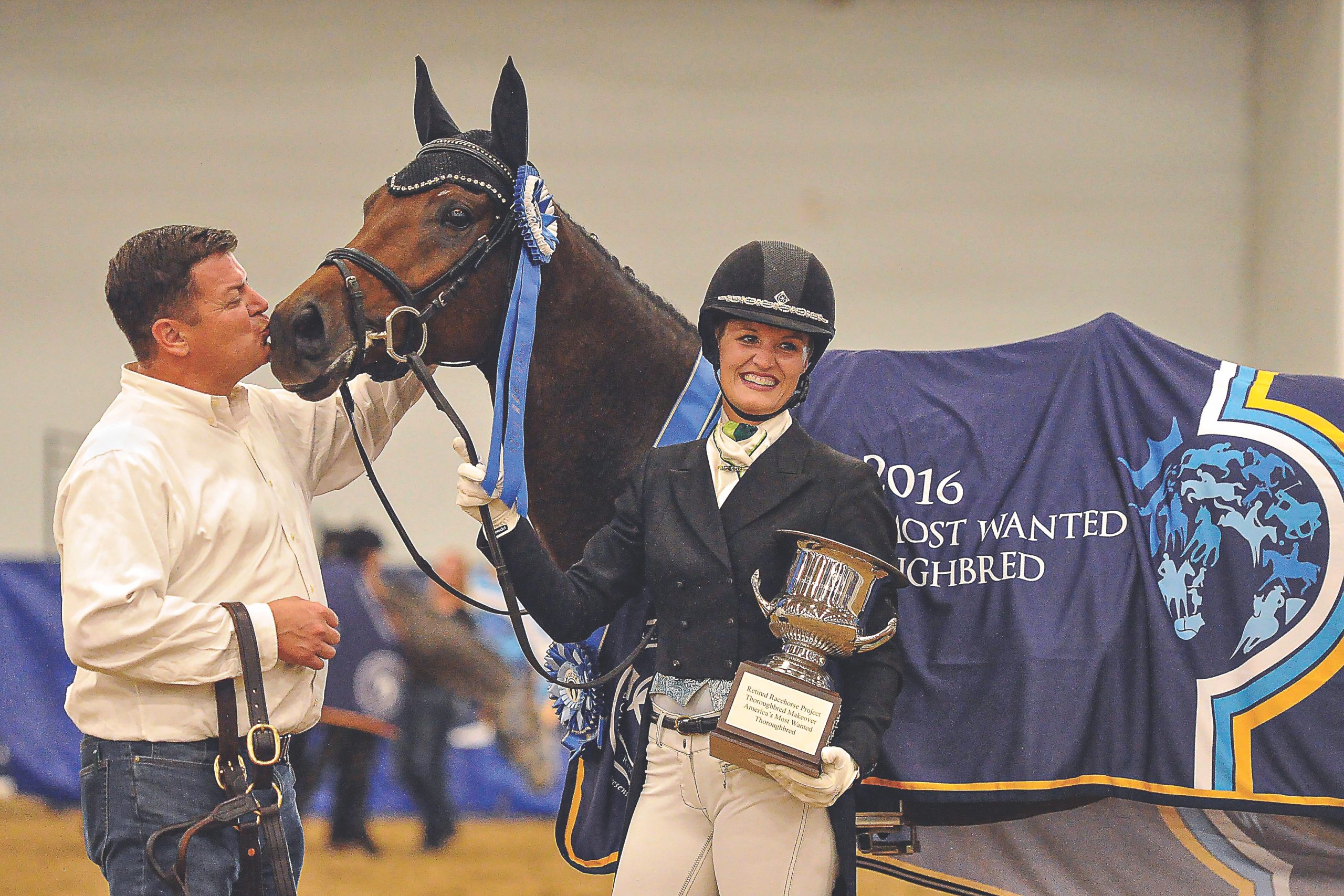
Thoroughbred Charities of America has been the Makeover’s title sponsor since its inception. Here, 2016 winner Fairway King stole a kiss from TCA president Mike McMahon. Photo courtesy Sarah K. Andrew
In 2018 Pittman announced he would be shifting to a political career, and he and the board asked Roytz if she would take the reins to lead the organization forward.
“One of the things I taught in entrepreneurship is the type of leadership that startup versus growing organizations need,” says Karlson. “Tapping Jen Roytz to become executive director was one of the smartest decisions we made.”
“2018 was such a pivotal year for the RRP,” says Green, “and I think Jen is to be credited with really taking what Steuart started and solidifying meaningful relationships with racing institutions and other entities in aftercare, and I think that’s really taken us to the next level.
“I remember talking with Steuart back in that summer of 2014 before I accepted my position with the RRP and candidly shared that I was a little worried about stability, joining an organization that was pretty young at the time,” says Green. “He told me ‘RRP isn’t going anywhere,’ and he was right. And he picked the right people to make sure of it.”
Since 2018 the Makeover has seen the addition of special awards, a major increase in prize money, a Makeover Master Class retraining event, a Thoroughbred Aftercare Summit and a slew of other enhancements Roytz says have been made possible by the RRP team, its dedicated board and TCA. She expects to see more expansion and add-ons, always keeping the organization’s mission in focus.
“Seeing that in each of the past few years a majority of our competitors are competing in the Makeover for the first time is a very telling statistic in my eyes. It means that we are playing a role in convincing equestrians to choose a Thoroughbred for the show ring, lesson barn, polo field, trails — you name it,” says Roytz. “At the end of the day, that’s what we’re all about — it’s why the RRP exists.”
The Future
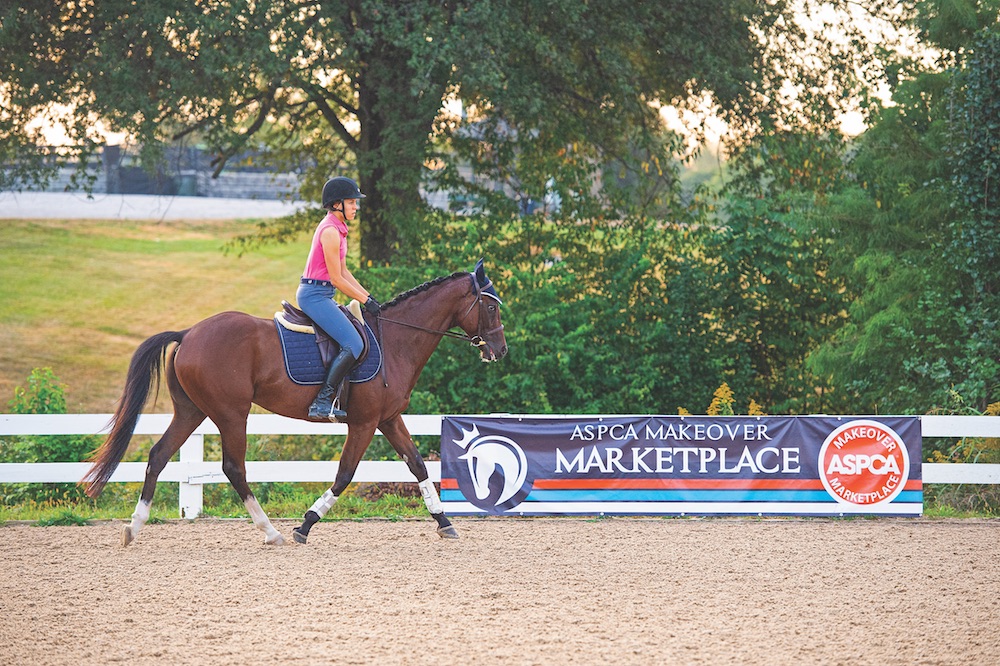
The ASPCA Makeover Marketplace has become one of the country’s premier sport horse shopping opportunities. Photo courtesy Anne Litz
In the next decade Roytz hopes to see the Makeover expand to bring more people into the Thoroughbred fold. “We’ve seen such interest in the event from people in the western half of the country. We’re also aware of the need for increasing demand for horses on the West Coast, as the market for Thoroughbreds after racing is not as robust in the western states as it is in the East, and we still have work to do in the East. We’re working on ways to better serve that population — both horses and equestrians — through clinics and other events with a goal of possibly someday hosting a West Coast version of the Thoroughbred Makeover if there is enough interest and support.”
In that vein, Green says, “Something we think about is regional qualifiers. I think we could serve more horses, and then the October event serves as a championship. I think it would help us reach more people, as well.”
She says she would love to see the championship, its audience and its vendor presence command the rental of the Alltech Arena at the Kentucky Horse Park, which offers more seating and a larger concourse for the trade show than does the covered arena, its current home.
Additionally, Roytz says the team has been considering how they can enhance the ASPCA Makeover Marketplace, which has become one of the country’s premier sport horse shopping opportunities, for riders in search of their next OTTBs.
“I think the RRP’s responsibility remains to those horses in their transition,” adds Green, “so I could see us creating more opportunities to get horses placed immediately after their retirement (rather than after the Makeover) — possibly an ASPCA Marketplace expansion to cover that population.”
Karlson hopes the RRP’s reach to racetracks can be broadened, as can the message of how important it is to retire sound horses. “I’d love to see more race trainers like Graham and Anita Motion, a team who thinks proactively about aftercare while horses in their training are still on the track,” she says. “I’d also like to broaden the concept of group trainers — college and high school equestrian teams, Pony Clubs, etc. — and extend our reach to international trainers.”
Aftercare: No Longer an Afterthought
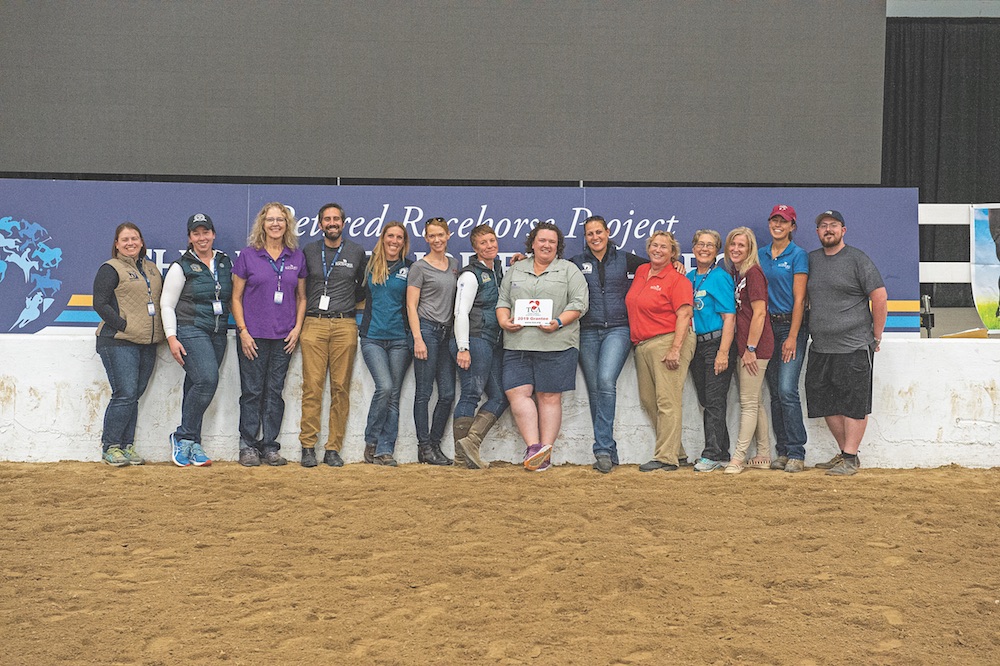
The RRP team and Makeover staff include Jennifer Crowl, Rhyan Banas, Sallie Roberts, Jonathan Horowitz, Ashley Gubich, Erin Crady, Dr. Shannon Reed, Kirsten Green, Jen Roytz, Julia Oughton, Peg Sorenson, Malinda Lawrence, Kristen Kovatch Bentley and Mike Green. Photo courtesy Anne Litz
The RRP’s efforts to increase demand for OTTBs are working. In 2014 the organization released a report called Bridges to Second Careers, which focused on how OTTB owners got their horses and for how much. At the time, the average purchase price or adoption fee was $1,985, and 31% were free. The average without free horses was $2,894.
“I think we can say that we’ve been a part of moving the needle on the biggest metric: the monetary value of these horses,” says Green. “We capture the cost of acquisition upon retirement — either direct from connections or if there was an intermediary reseller, agent or aftercare organization — as well as resale data on Makeover graduates. Both of those benchmark transactions are trending upward in the Makeover horse population, regardless of which ‘bridge’ they came over.”
Green points out that the figure in the Bridges study doesn’t reveal at which point in the horse’s post-track career it was acquired; it could’ve included prices immediately off-track and those after any number of years of retraining. So, while the average immediate off-track price for 2019 Makeover horses was $1,960, through all sources and excluding the free horses (which made up 29% of the total 598 horses impacted last year), sales reports to-date on 2019 horses indicate an average resale price of $8,620.
Anecdotally, Roytz has seen the popularity of OTTBs surge everywhere she’s traveled — prior to the coronavirus epidemic — to put on the organization’s Master Classes and speak on panels and at various conventions and events.
“Everywhere I go, whether it’s at one of those events or simply walking through the airport or down the street with my RRP gear on, I end up meeting people who share this passion for Thoroughbreds,” she says, “and it almost inevitably transitions into a conversation about a Thoroughbred that meant a lot to them and what they went on to do after racing. Whether they are involved with the racing industry professionally or are coming at it from the equestrian world, their love and admiration for Thoroughbreds and all they can do beyond what they’re typically known for on the track is the ultimate unifier.”
“Ten years ago the term ‘RRP eligible’ was not even a concept,” says Karlson. “Now it’s part of the common language of selling OTTBs. Likewise, ‘aftercare’ was an afterthought for so many owners and trainers; now it’s part of the horse ownership conversation upfront.
“As the owner of racehorses, I share the common dream of winning the ‘big’ races — Kentucky Derby, Preakness, Breeder’s Cup — as what would be life-defining goals,” she adds. “But I’ve come to realize that as wonderful as that would be, it’s one horse, on one day. What RRP has done is create a bigger dream and brighter futures for thousands of horses — an accomplishment of which I’m most proud.”
Author bio: Stephanie L. Church is the editor-in-chief of The Horse and Off-Track Thoroughbred. She and her OTTB gelding, It Happened Again, enjoy dressage and eventing.

